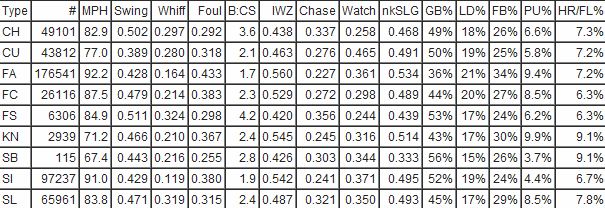I have been meaning to get to the Driveline Baseball article on pitch sequences and the use of data to optimize pitch selection, but the WS ender (and I can't get enough of this one) illustrates the "old-school" way (gut feeling) of doing same.
The Hardball Times article is the basis for Kyle Boddy's work at Driveline. I highlighted some of the areas I founf most helpful. I especially liked his point about telling pitcher that rather than focusing so much on "first-pitch strike" it was more important to string more 1-2 counts than 2-1. That way a miss on the first-pitch doesn't make them press later in the count to make up for the initial miss. More 2-2's than 3-2's are pretty important as well.
This is the battlefield where the war is fought in the pitcher-batter confrontation. The count. When the count is in the pitchers favor, good things happen. Sometimes, great things.
from Mercurynews.com:
WORLD SERIES NOTES: Romo comes up with a new trick; Scutaro sums it up | Giants Extra:
Miguel Cabrera, possibly the most dangerous hitter in the game (*non-Scutaro division), was sitting on a slider. The Sergio Romo slider — of which there are different variations — is as good as it gets, and Cabrera was waiting for it. He took the first one for a called strike and swung through the third one. With a 2-2 count, Cabrera fouled off another slider.
Five in a row, in the season’s biggest moment. Romo was protecting a one-run lead in the World Series, and he was doing what he does. Slider, slider, slider, slider, slider.
Then: Fastball. Right down the middle at 89 mph.
Cabrera was stunned as Buster Posey roared past him, both arms in the air. Posey had called for the slider and Romo shook his head. In the biggest moment of his career, Romo wasn’t going to throw his best pitch. It was a ballsy moment in a season full of them.
It’s a pitch that will be played over and over again for years to come. There’s the fastball and then there’s Romo, fists pumping, chest heaving, words screaming out of his mouth. In the background, there’s Cabrera, trying to figure out what the hell happened to that slider that he was sitting on.
“From the first pitch to the last pitch,” Cabrera said. “I was looking slider.”
'via Blog this'
from drivelinebaseball.com
http://www.drivelinebaseball.com/2012/05/28/choosing-the-correct-pitch-sequences-data-driven-decisions/
All pitchers (and parents of pitchers):My fellow author at The Hardball Times wrote an awesome article 2+ years ago about pitch types, and updated it in 2011. It’s pretty data-intensive:Large-scale data mining of MLB pitches using my database as well as Harry’s work has formed the backbone of why I teach the pitches I do, and the sequencing of them. Though I don’t get too in-depth into this when I work with you guys one-on-one, I figure it’s good to get this information out there for those who are really interested.For the younger guys, we always recommend training as a starter first, which means commanding two fastballs (four-seam fastball, two-seam fastball/sinker), a curve ball (12-6 or 1-7, preferably the former), a slider/cutter (depending on arm angle and comfort level – how we teach the cutter is basically a slider anyway), and a change-up (can just be the sinker if four-seam velo is < 80 MPH).Reproducing the relevant chart:Aside from splitters (not a pitch we generally teach for a variety of reasons), sliders (SL) have the best Whiff Rate, while curveballs (CU) have the best Watch Rate. Fastballs (FA) are the easiest to throw for strikes and generate a lot of foul balls, but the primary reason to throw fastballs is to set up the other pitches. Change-Ups (CH) and Sinkers (SI) have very good GB% rates.Everything works together. It’s important to realize the role of each pitch:-Fastballs set the hitters’ expectations for velocity, location, and allow you to easily get ahead in/back into strikeout counts (at the risk of being the easiest pitch to hit)
-Curveballs should be thrown early in counts to tough hitters to disrupt timing and late in counts (2 strikes) to weak hitters who are likely to take strike 3 (at the risk of being a pitch most brutally punished when the spot is missed)
-Sliders should almost always be thrown late in counts to strike hitters out; giving hitters an early look at your left-right breaking ball is generally a huge mistake (at the risk of being a very hard pitch to throw for reliable strikes)
-Change-Ups should be saved for the 2nd and 3rd time through the lineup for a secondary “breaking ball” to get hitters out with; can be used for GIDP situations (at the risk of being a high-contact high-average pitch)
-Sinkers/two-seam fastballs should be used against opposite-hand hitters as you would use your fastball; lean on it heavily to neutralize the platoon advantage and minimize the # of four-seam fastballs thrown to opposite-side hitters (at the risk of being a high-contact high-average pitch)
–Use sinkers/two-seam fastballs for GIDPs, though I recommend against this for pitchers not playing for elite college/select teams (how many GIDPs does the average youth team turn anyway?)A same-handed hitter perceives a pitch thrown up-and-in to be up to 10% harder than a pitch thrown low-and-away. Watch/take rates go up the bigger the difference between pitch n and pitch n+1 become – this means you should use fastballs in to setup curveballs which setup sliders. Be economical with your pitches and don’t be afraid to experiment. While you don’t need to throw your cutter/slider for strikes reliably, you need to get into as many 1-2 or better counts as possible.First pitch strikes are important, but the first three pitches together matter the most. The difference between 1-2 and 2-1 is incredibly huge, which is why pitchers should be able to throw all pitches for a combined strike rate of 66%+.Hope this isn’t too much data!


No comments:
Post a Comment